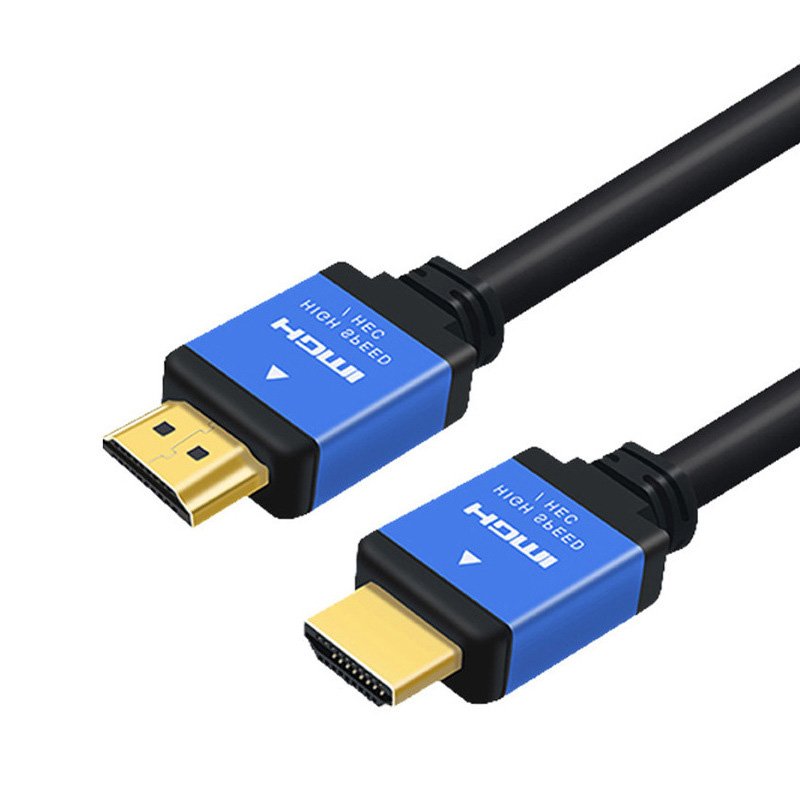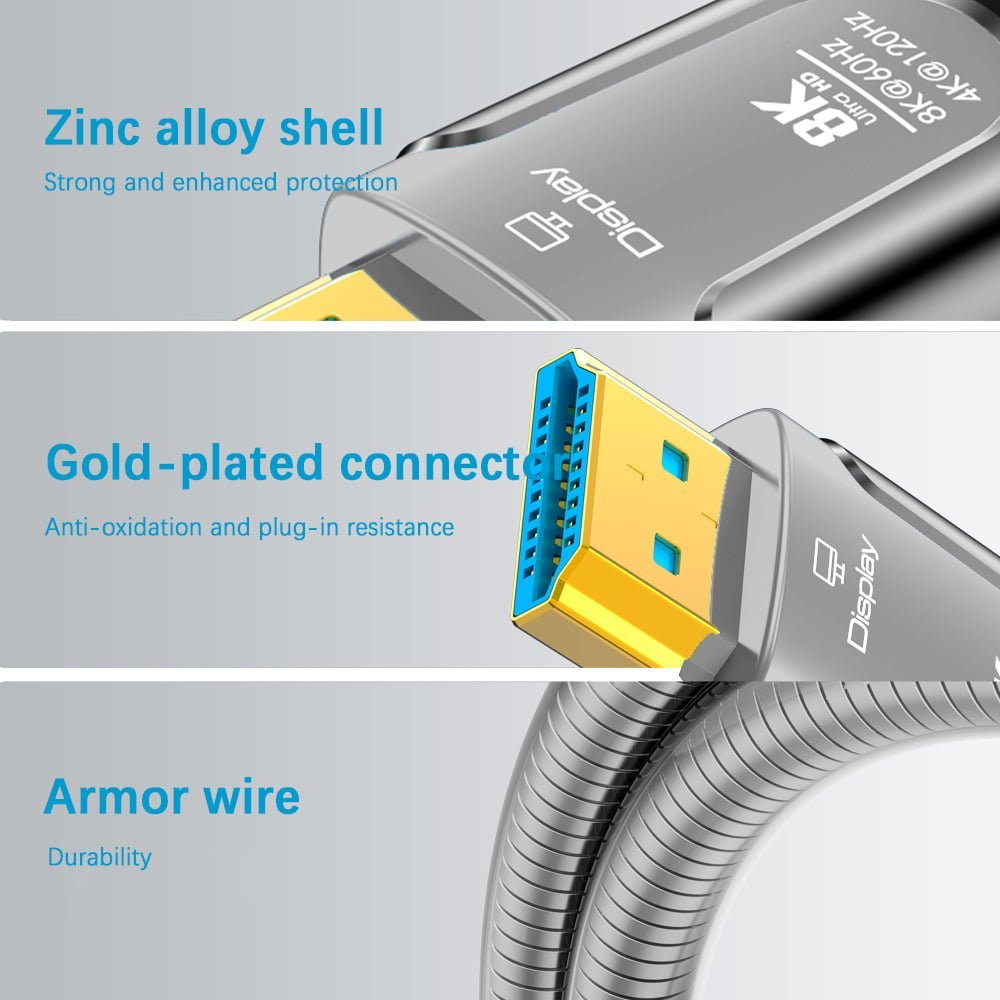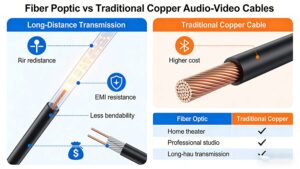HDMI-Kabel (High-Definition Multimedia Interface) sind zum Standard für die Übertragung hochwertiger Audio- und Videosignale zwischen Geräten geworden. Aber wenn Sie ein Heimkino einrichten, einen Computer mit einem Monitor verbinden oder andere Geräte anschließen möchten, fragen Sie sich vielleicht: Wie lange kann ein HDMI-Kabel sein? Wir wollen dieser Frage nachgehen und herausfinden, welche Faktoren dabei eine Rolle spielen.
Die Grundlagen von HDMI-Kabeln
HDMI-Kabel sind für die Übertragung unkomprimierter digitaler Audio- und Videosignale ausgelegt. Sie haben ältere Verbindungstypen ersetzt wie VGA und Komponentenkabel, weil sie eine Einkabellösung für hochauflösende Inhalte bieten. HDMI-Kabel werden in einer Vielzahl von Geräten verwendet, von Fernsehern und Projektoren bis hin zu Laptops, Spielkonsolen und Blu-ray-Playern.
Faktoren, die die Länge von HDMI-Kabeln beeinflussen
Signalverschlechterung
Als ein HDMI-Kabel länger wird, kann sich das Signal, das es überträgt, verschlechtern. Das liegt daran, dass die elektrischen Signale, die durch das Kabel übertragen werden, mit zunehmender Entfernung schwächer werden. Je länger das Kabel ist, desto wahrscheinlicher ist es, dass Sie Probleme wie Pixelbildung, Farbverzerrungen oder einen vollständigen Signalverlust erleben. Dieses Phänomen wird als Dämpfung bezeichnet und ist ein natürlicher Bestandteil des Verhaltens von elektrischen Signalen.
Qualität der Kabel
Die Qualität des HDMI-Kabels spielt eine wichtige Rolle bei der Länge des Kabels. Qualitativ hochwertigere Kabel werden aus besseren Materialien hergestellt, z. B. dickeren Kupferleitern und einer effektiveren Abschirmung. Diese Kabel sind besser in der Lage, die Integrität des Signals über längere Strecken aufrechtzuerhalten. Billigere Kabel hingegen können lange Strecken nicht so gut bewältigen und sind anfälliger für Signalverschlechterungen.
HDMI-Version
Es gibt verschiedene HDMI-Versionen, jede mit ihren eigenen Fähigkeiten. Neuere Versionen wie HDMI 2.1 unterstützen höhere Auflösungen (z. B. 8K) und Bildwiederholraten, benötigen aber auch mehr Bandbreite. Je höher die Bandbreitenanforderungen sind, desto schwieriger kann es sein, das Signal über lange Strecken zu übertragen. Ältere HDMI-Versionen sind möglicherweise in der Lage, längere Kabelstrecken für Inhalte mit niedrigerer Auflösung zu bewältigen.
Empfohlene HDMI-Kabellängen
Standard-HDMI-Kabel
Standard-HDMI-Kabel werden normalerweise für Auflösungen bis zu 1080i oder 720p verwendet. Die empfohlene Maximallänge für diese Kabel beträgt etwa 7,6 Meter (25 Fuß). Bei Überschreitung dieser Länge können Sie eine Verschlechterung der audiovisuellen Qualität feststellen.
Hochgeschwindigkeits-HDMI-Kabel
Hochgeschwindigkeits-HDMI-Kabel sind für höhere Auflösungen ausgelegt, einschließlich 1080p, 4K und mehr. Sie bieten eine höhere Bandbreite, um diese erweiterten Funktionen zu unterstützen. Aufgrund der höheren Bandbreitenanforderungen ist die maximal empfohlene Länge für Hochgeschwindigkeitskabel jedoch kürzer, in der Regel etwa 4,6 m (15 Fuß).
Aktive HDMI-Kabel
Aktive HDMI-Kabel sind eine andere Art. Sie enthalten eine Signalverstärkungstechnologie, die dazu beiträgt, die Signalintegrität über größere Entfernungen aufrechtzuerhalten. Einige aktive HDMI-Kabel können Längen von bis zu 30 Metern (100 Fuß) oder mehr unterstützen. Sie sind jedoch in der Regel teurer und erfordern möglicherweise eine externe Stromquelle.
Lösungen für die HDMI-Übertragung über große Entfernungen
HDMI-Extender
HDMI-Extender sind eine großartige Option zur Erweiterung der Reichweite Ihres HDMI-Signals. Sie funktionieren, indem sie das HDMI-Signal über Ethernet-Kabel oder Glasfaser übertragen. Dadurch können Sie Entfernungen von über 30 Metern (100 Fuß) mit minimaler Signalverschlechterung erreichen. HDMI-Extender werden häufig in professionellen Installationen verwendet, z. B. in Konferenzräumen oder Heimkinos, wo lange Kabelwege erforderlich sind.
Faseroptische HDMI-Kabel
Schlussfolgerung
Zusammenfassend lässt sich sagen, dass die maximale Länge eines HDMI-Kabel hängt von mehreren Faktoren ab, wie z. B. der Signalverschlechterung, der Kabelqualität und der HDMI-Version. Es gibt zwar allgemeine Richtlinien für Kabellängen, aber am besten ist es, wenn Sie Ihre spezifischen Bedürfnisse und die von Ihnen verwendeten Geräte berücksichtigen. Wenn Sie ein HDMI-Kabel über eine lange Strecke verlegen müssen, sind Optionen wie aktive HDMI-KabelHDMI-Verlängerungen, oder HDMI-Glasfaserkabel kann Ihnen helfen, eine zuverlässige Verbindung mit hoher Audio- und Videoqualität herzustellen.
| HDMI-Kabel Typ | Ungefähre maximale Länge | Unterstützte Auflösungen | Ungefähre Preisspanne |
|---|---|---|---|
| Standard-HDMI-Kabel | 25 Fuß (7,6 Meter) | Bis zu 1080i oder 720p | $5 – $20 |
| Hochgeschwindigkeits-HDMI-Kabel | 15 Fuß (4,6 Meter) | 1080p, 4K und höher | $10 – $30 |
| Aktive HDMI-Kabel | 100 Fuß (30 Meter) oder mehr | Je nach Modell unterschiedlich, unterstützt hohe Auflösungen | $30 – $100+ |










